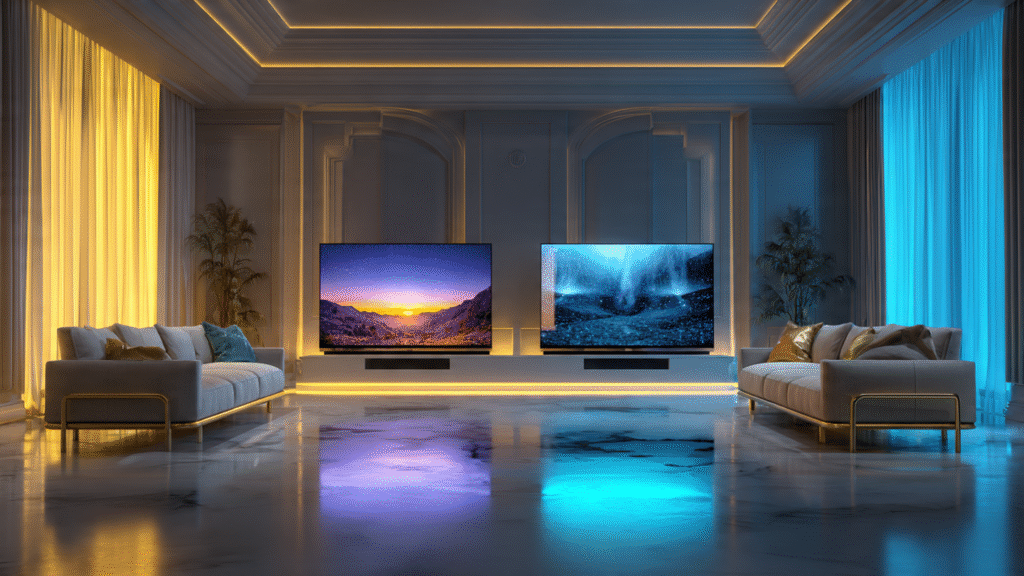If you’re buying a new TV in 2025, chances are you’re comparing OLED vs LED TVs. Both technologies have improved dramatically over the years, but they offer very different viewing experiences. Choosing the right one depends on your needs, budget, and viewing environment.
This guide breaks down the key differences between OLED and LED TVs, their pros and cons, and the questions you should ask before making a decision.

What is an LED TV?
- Technology: LED TVs are LCD TVs that use light-emitting diodes (LEDs) for backlighting.
- How it works: A backlight passes through liquid crystal pixels to create an image.
- Variants: Standard LED, QLED (Quantum Dot LED), and Mini-LED (smaller LEDs for better precision).
- Strengths: Brightness, affordability, long lifespan.
What is an OLED TV?
- Technology: OLED stands for Organic Light Emitting Diodes.
- How it works: Each pixel produces its own light, allowing for perfect black levels and infinite contrast.
- Strengths: Exceptional contrast, thin design, wide viewing angles, cinematic picture quality.
OLED vs LED: Key Differences
| Feature | OLED | LED (QLED/Mini-LED) |
|---|---|---|
| Picture Quality | Perfect blacks, infinite contrast | Good contrast, but limited by backlight |
| Brightness | Lower peak brightness | Higher peak brightness, better for bright rooms |
| Viewing Angles | Excellent, no color washout | Narrower, colors fade off-angle |
| Color Accuracy | Rich, lifelike colors | Improved with QLED/Mini-LED, but not as deep |
| Design | Ultra-thin, flexible | Slightly thicker due to backlight |
| Burn-in Risk | Possible with static images | No burn-in issues |
| Lifespan | 8–10 years (with care) | 10+ years |
| Price | Higher, premium models | Wide price range, budget to premium |
Pros and Cons of OLED TVs
Pros:
- Perfect black levels and contrast
- Stunning picture quality for movies and gaming
- Ultra-thin and sleek designs
- Wide viewing angles
Cons:
- Expensive compared to LED
- Risk of burn-in (static images left for long periods)
- Lower peak brightness (less ideal for sunlit rooms)
Pros and Cons of LED TVs
Pros:
- Brighter screens, great for daylight viewing
- More affordable and available in more sizes
- Longer lifespan without burn-in risk
- Excellent gaming performance (with newer Mini-LED/QLED models)
Cons:
- Blacks are not truly black (slight gray glow in dark scenes)
- Narrower viewing angles
- Bulkier design compared to OLED
Which is Better for Different Uses?
- For Movies & Home Theater: OLED – best cinematic experience, deep blacks, immersive visuals.
- For Gaming: Both are strong. OLED offers faster response times, while LED/Mini-LED can be brighter and more durable.
- For Bright Rooms: LED/QLED/Mini-LED – better brightness levels to combat glare.
- For Everyday TV Watching: LED is cost-effective and practical.
- For Design Lovers: OLED’s slim and futuristic build is unmatched.
FAQs: OLED vs LED TV
Is OLED worth the extra money?
Yes, if you prioritize picture quality, wide viewing angles, and a premium design.
Does OLED burn-in still happen in 2025?
It’s rare with modern OLED TVs, thanks to pixel-shifting technologies, but heavy static image use (like logos or HUDs in games) can still cause it.
Which lasts longer: OLED or LED?
LED TVs typically last longer, but OLED TVs can easily last 8–10 years with normal use.
Which TV is best for sports?
OLED offers smoother motion and wider angles, while LED’s brightness may be better for daytime sports viewing.
Conclusion: Which TV Should You Buy in 2025?
If you want cinema-quality visuals, deep blacks, and cutting-edge design, OLED TVs are the clear winner.
If you need a brighter, more affordable, and durable option, LED/QLED/Mini-LED TVs still deliver excellent performance. Also, read about Robot Vacuum Buying Guide 2025: Everything You Need to Know.
👉 Final Recommendation:
- Choose OLED if you’re building a home theater or want the best possible visuals.
- Choose LED/QLED/Mini-LED if you watch TV in bright rooms, play games for long hours, or want better value for money.
Disclaimer: This guide is for informational purposes only. Product features and prices may vary depending on brand and model. Always compare official specifications before purchasing.